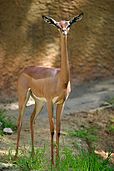Wildlife of Somaliland
The wildlife of Somaliland includes the
. The coastal region is more humid due to its proximity to the ocean. Somaliland is home to over 727 bird species and boasts over 177 species of mammals.Somaliland is home to a diverse variety of flora and fauna, from acacia trees, to birds, large cats, and reptiles large and small.
In some areas, the mountains are covered with shrubs such as pyracantha, jasmine, poinsettia, and a varied assortment of evergreens. Caraway, carcade, cardamom, coriander, incense, myrrh, and red pepper are common.
Lexicology
There are many forms of terminology and ways of describing the subphylums, metonyms and classifications of the various animals living within Somaliland. These include bahal ('creature'), doobjoog ('domestic animal/pet'), duurjoog/dugaag ('wild/undomesticated animal'), hangaguri ('general animal'), dalanga or its determiner form dalangihi ('chordate'), naasley ('mammal'), xasharaad ('insect'), beribiyood ('amphibian'), xamaarato ('reptile'), and noole ('organism').[1]
Fauna
Mammals
Somaliland contains a variety of mammals due to its geographical and climatic diversity. Wild animals are found in every region. Among the latter are the
Since elephants are migratory, they are found in a variety of habitats, such as woodland, savanna, and
The following mammals are found exclusively in Somaliland:
Birds


Somaliland is currently home to about 727 bird species, of which eight are
- Red-eyed dove (Streptopelia semitorquata) (Somali: Qoolay)
- Speckled pigeon (Columba guinea guinea) (Somali: Xamaam)
- White-backed vulture (Gyps africanus)
- Namaqua dove (Oena capensis)
- Somali bulbul (Pycnonotus somaliensis)
- Somali pigeon (Columba oliviae)
- Black boubou (Laniarius nigerrimus)
- Lesser hoopoe-lark (Alaemon hamertoni)
- Archer's lark (Heteromirafra archeri)
- Ash's bushlark (Mirafra ashi)
- Somali bushlark (Mirafra somalica)
- Warsangli linnet (Linaria johannis)
Reptiles
Somaliland has roughly 235 species of reptiles.
Reptiles unique to Somaliland include
Fish

With 740 km of coastline facing the Red Sea, Somaliland waters are prime fishing grounds for highly migratory fish species such as tuna and tuna-like species, and a narrow but productive continental shelf is the home to several
Fish species found exclusively in Somaliland include:
- Cirrhitichthys randalli
- Symphurus fuscus
- Parapercis simulata
- Cociella somaliensis
- Pseudochromis melanotus
Flora
The highlands, which in an almost continuous line traverse East Africa, have to a great extent isolated the flora of Somaliland in spite of the general resemblance of its climate and soil to the country on the western side of the band of high ground. The greater part of the country is covered either with tall coarse grasses, or more commonly with thick thorn-bush or jungle, among which rise occasional isolated, trees. The prevalent bush plants are khansa,
.Among the larger trees are the mountain cedar, reaching to 100 feet (30 m); the gob, which bears edible berries in appearance something like the cherry with the taste of an apple, grows to some 80 feet (24 m). There are patches of dense reeds, reaching 10 feet (3.0 m) high, and thickets of
The following vascular plant genera are found exclusively in Somaliland:[7]
- Boswellia occulta (Burseraceae) The new species Boswellia occulta is described from a small area in the El Afweyn District of Somaliland, where it is locally of considerable socio-economic importance. Although used for frankincense production by many generations of local harvesters, it has been unknown to science until now.
- Iphiona rotundifolia (Somali: gagabood)
- Euphorbia inculta (Somali: dibow)
- Odontanthera radians, a member of the family Apocynaceae, which is found in the coastal and subcoastal areas of Somaliland. (Somali: sobkax)
- Balanites rotundifolia (Somali: kulan)
- Boscia miminifolia (Somali: maygaag)
- Vachellia tortilis (Somali: qudhac)
- Eriostylos 1 sp.
- Polyrhabda 1 sp.
- Goydera 1 spp.
- Whitesloanea 1 sp.
- Puccionia 1 sp.
- Afrotrichloris 2 spp.
- Pseudozoysia 1 sp.
- Taeniorhachis 1 sp.
- Renschia 1 sp.
- Symphyochlamys1 sp.
National animals
- National animal: kudu
Notes
- ^ Puglielli, Annarita, and Cabdallah Cumar Mansuur. "Grammatica della lingua somala per le scuole superiori." (2013).
- . Retrieved 15 January 2018.
- ^ Wilson, D.E. & Reeder, D.M. (Eds.) (2005). Mammal Species of the World: A Taxonomic and Geographic Reference. Third Edition. Johns Hopkins University Press, Baltimore.
- ^ Dickinson, E.C. (Ed.)(2003) The Howard and Moore Complete Checklist of the Birds of the World. Revised and enlarged third edition. Princeton University Press, Princeton.
- ^ Uetz, P. & Jirí Hošek (eds.), The Reptile Database, htUetz, P. & Jirí Hošek (e Uetz, P. & Jirí Hošek (eds.), The Reptile Database, http://www.reptile-database.org, accessed Dec 8, 2013
- ^ FishBase 2004: a global information system on fishes. DVD. WorldFish Center - Philippine Office, Los Banos, Philippines. Published in May 2004
- ^ Mabberley, D.J. (2008) Mabberley's Plant-book. Third Edition. Cambridge University Press, Cambridge.
References
- Mazuch, Tomas (ed.). Venomous Snakes in Somaliland.
- Wilson, Don E.; Reeder, DeeAnn M., eds. (2005). Mammal Species of the World: A Taxonomic and Geographic Reference (3rd ed.). Johns Hopkins University Press. Retrieved 3 August 2009.
- "Somaliland Biodiversity Foundation". Retrieved 24 July 2021.
- "Boswellia occulta (Burseraceae), a new species of frankincense tree from Somalia (Somaliland)". . Retrieved 24 July 2021.
- "Animal Diversity Web". University of Michigan Museum of Zoology. 1995–2006. Retrieved 22 May 2007.









